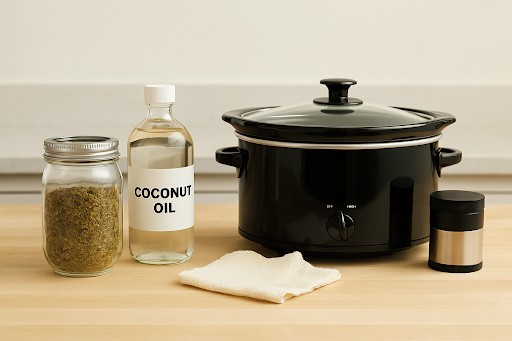Ever find yourself staring at your CBD oil bottle, wondering just how it was made and whether there’s a way to create your own batch? Well, you’re not alone. For years, I’ve been asked by friends, family, and even colleagues in the wellness world about how to make CBD oil at home. It’s a great question, especially if you’re the DIY type, but there are a few things you need to know before diving into this endeavor. If you’ve ever thought about crafting your own batch of CBD oil, this guide is for you. Let’s get into the nuts and bolts of it.
What Exactly is CBD Oil?
Before we start talking about making CBD oil, let’s quickly clear up what it is. CBD, short for cannabidiol, is one of the many compounds found in cannabis plants. Unlike THC (the psychoactive compound), CBD is non-intoxicating, meaning it won’t get you high, but it’s believed to have a variety of wellness benefits, such as supporting anxiety relief, reducing inflammation, and improving sleep.
CBD oil is typically made by extracting CBD from hemp or cannabis plants and then infusing it into a carrier oil, like coconut oil or olive oil. It sounds simple enough, right? But, as with all things wellness-related, the process isn’t as straightforward as it might seem. And that’s exactly what we’re going to unpack.
Why Make CBD Oil at Home?
You might be wondering: Why bother making CBD oil yourself when it’s so readily available in stores? Great question. There are a few reasons why making your own CBD oil might be appealing:
- Customization: You can control the potency and ingredients. Want a higher concentration? You’ve got it. Prefer a certain carrier oil, like almond or MCT oil? Done.
- Purity: When you make your own oil, you know exactly what goes into it. No fillers, additives, or mystery chemicals.
- Cost-Effectiveness: While there’s an upfront investment in materials, making your own CBD oil can be much cheaper in the long run compared to buying pre-made products.
So, now that you know why you might want to make your own CBD oil, let’s talk about how to make CBD oil.
What You’ll Need to Make CBD Oil
To make your own CBD oil, there are a few basic ingredients and tools you’ll need to get started. While the process is relatively simple, it does require some careful attention to detail. Here’s what you’ll need:
- CBD-rich hemp flower: The star ingredient. You’ll need high-quality hemp that’s rich in CBD, and it must contain less than 0.3% THC to keep it legal. You can find hemp flowers online or at local dispensaries.
- Carrier oil: This is what the CBD is going to dissolve into. Popular choices include coconut oil, olive oil, or MCT oil. Coconut oil is a great option because of its health benefits and neutral taste.
- Double boiler or slow cooker: A double boiler is ideal for gentle heating, but if you don’t have one, a slow cooker works just as well.
- Cheesecloth or fine strainer: You’ll need this to strain out the plant material after the extraction process is complete.
- A grinder: You’ll need this to break down the hemp flower into smaller pieces, which allows the oil to extract more efficiently.
- A jar or container: For storing your finished product.
How to Make CBD Oil: Step-by-Step
Now, let’s get to the fun part: making the CBD oil itself. Follow these steps, and you’ll have your own homemade CBD oil in no time.
Step 1: Decarboxylate the Hemp Flower
 Credit: Gemini
Credit: Gemini
Before you can make CBD oil, you need to activate the cannabinoids in the hemp. This process is known as decarboxylation, and it involves heating the hemp to a certain temperature to activate its compounds.
To do this:
- Preheat your oven to 220°F (104°C).
- Break up your hemp flower into small pieces and spread them out on a baking sheet lined with parchment paper.
- Bake for about 30-45 minutes. You’ll know it’s ready when the hemp smells slightly nutty and has turned a light golden-brown color.
This process is crucial because without it, the CBD won’t be as potent.
Step 2: Combine the Hemp with the Carrier Oil
 Credit: Gemini
Credit: Gemini
Once your hemp is decarboxylated, it’s time to infuse it with your carrier oil. Here’s where you get to pick your favorite oil.
- Add about 1 cup of your decarboxylated hemp flower into your double boiler or slow cooker.
- Pour in 2-3 cups of your chosen carrier oil (adjust depending on how concentrated you want the final product).
- Heat the mixture on low for 2-3 hours. If you’re using a double boiler, make sure the water is gently simmering—not boiling. If you’re using a slow cooker, keep it on the low setting.
- Stir occasionally and ensure the mixture doesn’t overheat—maintaining a temperature of around 200°F (93°C) is ideal.
This slow and steady heating process helps extract the CBD into the oil.
Step 3: Strain the Oil
 Credit: Gemini
Credit: Gemini
After 2-3 hours, your CBD oil should be ready to strain. Let the oil cool down slightly, then use a cheesecloth or fine strainer to remove the plant material. Make sure to squeeze out every last bit of oil from the hemp to get the most out of your batch.
Step 4: Store Your CBD Oil
Once strained, pour the oil into a clean, airtight jar or container. Store it in a cool, dark place, away from heat and direct sunlight. Your homemade CBD oil should last about 2-3 weeks, but you can extend its shelf life by refrigerating it.
How to Make the Most of Your Homemade CBD Oil
Making CBD oil is just the first step—now it’s time to incorporate it into your wellness routine. Whether you’re using it for relaxation, pain relief, or sleep, here are a few tips for making the most out of your homemade CBD oil:
- Start Slow: As with any CBD product, start with a small dose and see how your body responds. If you’re using it for sleep, try taking it 30-60 minutes before bed.
- Use Consistently: CBD is most effective when used regularly. Consistency is key, so try incorporating it into your daily routine, whether it’s added to your morning smoothie or used in the evening as part of your wind-down ritual.
- Experiment with Application: You can take CBD oil sublingually (under the tongue) for faster absorption, or mix it into food and drinks for a slower, more sustained effect.
 Credit: Gemini
Credit: Gemini
Frequently Asked Questions
-
Is homemade CBD oil as effective as store-bought versions?
Homemade CBD oil can be just as effective if made properly. However, store-bought products often undergo rigorous testing for potency and purity. If you’re making it at home, make sure you’re sourcing high-quality hemp and following the extraction process carefully.
-
How do I know how much CBD is in my homemade oil?
Unlike commercially produced CBD oil, homemade batches may not come with clear dosing information. The strength of your CBD oil will depend on the amount of hemp you use and how long it’s infused. If potency is important to you, consider sending a sample to a lab for testing.
-
Can I make CBD oil without decarboxylating the hemp?
Technically, yes, but decarboxylating helps activate the cannabinoids for a more potent effect. Skipping this step means your CBD oil may be less effective. It’s best to include it for maximum benefits.
-
Can I use CBD oil for cooking?
Absolutely! Homemade CBD oil can be used in cooking or baking. Just keep in mind that high heat can degrade the CBD, so try to add it to recipes that don’t require excessive cooking or baking temperatures.
The Bottom Line: DIY CBD for the Win
So, is making CBD oil at home worth it? If you’re into DIY projects and care about knowing exactly what’s in your product, then absolutely. It gives you complete control over the process, from the type of hemp you use to the carrier oil and potency. Just be sure to follow the process carefully, start slow with dosage, and, most importantly, have fun with it!
Personal Tip: While it’s super rewarding to make your own CBD oil, don’t forget to source high-quality hemp. It’s the foundation of your oil, and the better your starting material, the better your final product will be. Happy making!












